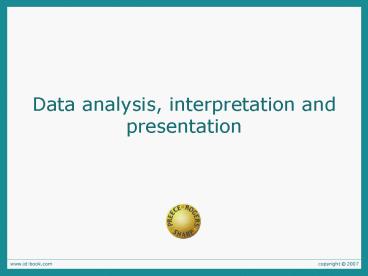Data analysis, interpretation and presentation - PowerPoint PPT Presentation
1 / 16
Title:
Data analysis, interpretation and presentation
Description:
Quantitative analysis numerical methods to ascertain size, magnitude, amount. Qualitative analysis expresses the nature of elements and is represented as ... – PowerPoint PPT presentation
Number of Views:759
Avg rating:3.0/5.0
Title: Data analysis, interpretation and presentation
1
Data analysis, interpretation and presentation
2
Overview
- Qualitative and quantitative
- Simple quantitative analysis
- Simple qualitative analysis
- Tools to support data analysis
- Theoretical frameworks grounded theory,
distributed cognition, activity theory - Presenting the findings rigorous notations,
stories, summaries
3
Quantitative and qualitative
- Quantitative data expressed as numbers
- Qualitative data difficult to measure sensibly
as numbers, e.g. count number of words to measure
dissatisfaction - Quantitative analysis numerical methods to
ascertain size, magnitude, amount - Qualitative analysis expresses the nature of
elements and is represented as themes, patterns,
stories - Be careful how you manipulate data and numbers!
4
Simple quantitative analysis
- Averages
- Mean add up values and divide by number of data
points - Median middle value of data when ranked
- Mode figure that appears most often in the data
- Percentages
- Graphical representations give overview of data
5
Simple qualitative analysis
- Unstructured - are not directed by a script. Rich
but not replicable. - Structured - are tightly scripted, often like a
questionnaire. Replicable but may lack richness. - Semi-structured - guided by a script but
interesting issues can be explored in more depth.
Can provide a good balance between richness and
replicability.
6
Visualizing log data
Interaction profiles of players in online game
Log of web page activity
7
Simple qualitative analysis
- Recurring patterns or themes
- Emergent from data, dependent on observation
framework if used - Categorizing data
- Categorization scheme may be emergent or
pre-specified - Looking for critical incidents
- Helps to focus in on key events
8
Tools to support data analysis
- Spreadsheet simple to use, basic graphs
- Statistical packages, e.g. SPSS
- Qualitative data analysis tools
- Categorization and theme-based analysis, e.g. N6
- Quantitative analysis of text-based data
- CAQDAS Networking Project, based at the
University of Surrey (http//caqdas.soc.surrey.ac.
uk/)
9
Theoretical frameworks for qualitative analysis
- Basing data analysis around theoretical
frameworks provides further insight - Three such frameworks are
- Grounded Theory
- Distributed Cognition
- Activity Theory
10
Grounded Theory
- Aims to derive theory from systematic analysis of
data - Based on categorization approach (called here
coding) - Three levels of coding
- Open identify categories
- Axial flesh out and link to subcategories
- Selective form theoretical scheme
- Researchers are encouraged to draw on own
theoretical backgrounds to inform analysis
11
Distributed Cognition
- The people, environment artefacts are regarded
as one cognitive system - Used for analyzing collaborative work
- Focuses on information propagation
transformation
12
Activity Theory
- Explains human behavior in terms of our practical
activity with the world - Provides a framework that focuses analysis around
the concept of an activity and helps to
identify tensions between the different elements
of the system - Two key models one outlines what constitutes an
activity one models the mediating role of
artifacts
13
Individual model
14
Engeströms (1999) activity system model
15
Presenting the findings
- Only make claims that your data can support
- The best way to present your findings depends on
the audience, the purpose, and the data gathering
and analysis undertaken - Graphical representations (as discussed above)
may be appropriate for presentation - Other techniques are
- Rigorous notations, e.g. UML
- Using stories, e.g. to create scenarios
- Summarizing the findings
16
Summary
- The data analysis that can be done depends on the
data gathering that was done - Qualitative and quantitative data may be gathered
from any of the three main data gathering
approaches - Percentages and averages are commonly used in
Interaction Design - Mean, median and mode are different kinds of
average and can have very different answers for
the same set of data - Grounded Theory, Distributed Cognition and
Activity Theory are theoretical frameworks to
support data analysis - Presentation of the findings should not overstate
the evidence














![Construction and Interpretation of Simple Diagrams and Graphs [I] PowerPoint PPT Presentation](https://s3.amazonaws.com/images.powershow.com/7658618.th0.jpg?_=20160307021)
















